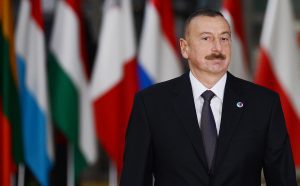
The Ministries of Foreign Affairs of Ukraine and Azerbaijan have agreed to prepare for the official visit of President of Azerbaijan Ilham Aliyev to Ukraine before the end of 2020, the press service of the Ministry of Foreign Affairs of Ukraine said.
“On June 17, another round of political consultations took place at the level of Deputy Foreign Ministers of Ukraine Vasyl Bodnar and the Republic of Azerbaijan Khalaf Khalafov in the form of a videoconference, during which further cooperation was comprehensively discussed, including on supporting the territorial integrity of both states and certain aspects of the policy regarding the occupied territories,” the ministry said in a statement.
Thus, the diplomats emphasized the importance of maintaining the existing dynamics of political dialogue and agreed to concentrate efforts on preparing the official visit of Azerbaijani President Aliyev to Ukraine before the end of 2020.
“I’m sure that the official visit of the Azerbaijani leader to Ukraine will be a significant impetus for strengthening strategic partnerships and will allow serious advancing implementation of joint projects,” Bodnar said.
The parties agreed to intensify the work of ministries and departments to prepare joint initiatives, programs and documents, as well as hold meetings of bilateral working bodies.
Among other things, the parties discussed practical steps to implement projects in the political, trade, economic, energy, transport, cultural, humanitarian and military-technical fields.

President of Ukraine Volodymyr Zelensky declares that Ukraine seeks full membership in the European Union.
“Eastern Partnership shouldn’t limit the ambitions of its partners. For some, political dialogue or strategic partnership with EU is enough, some seek integration with the common market on the basis of 4 freedoms, but Ukraine seeks full membership of the EU,” he wrote on Twitter on Thursday.
On June 18, the Eastern Partnership summit is held in video mode with the participation of the EU leadership, the heads of the Eastern Partnership states and the heads of all EU member states.
According to the presidential press service, the head of state reminded that from the beginning the goal of the initiative was to build the EU community with partners who share European values and principles. At the same time, the benefits of such an association should be enjoyed by all citizens of the countries – participants.
The president of Ukraine expressed confidence in the possibility of jointly overcoming the challenges of today, in particular the consequences of the coronavirus pandemic, by deepening integration and increasing coordination between countries, rather than by political self-isolation and protectionism.
“This meeting is a great opportunity to discuss further cooperation to overcome the current crisis and overcome similar challenges in the future. We are facing very difficult tasks: to protect the lives and health of citizens, to restore people-to-people and business contacts, to bring the economy out of the crisis trajectory,” the president said.
The president also thanked the European Union for its support, in particular for the new EUR 1.2 billion macro-financial assistance program, which is important and timely.
In addition, according to Zelensky, Ukraine counts on cooperation with the EU in the purchase of the COVID-19 vaccine as soon as it is produced.
The head of state noted that Ukraine, for its part, also supported European partners. In particular, Ukrainian medics came to the aid of Italian colleagues, and Ukrainian planes delivered medical supplies to many EU countries.
“I am sure that the slogan Stronger Together is more relevant today than ever,” the president of Ukraine said.

The European Bank for Reconstruction and Development (EBRD) will finance the reconstruction of the Dnipro-Mariupol and Dnipro-Kotovka roads in Dnipropetrovsk region, EBRD Senior Adviser for External Affairs Anton Usov said on his Facebook page. “The head of Dnipropetrovsk region, Oleksandr Bondarenko, and the EBRD Deputy Director in Ukraine, Mark Magaletsky, have signed an agreement to begin preparing a project for the reconstruction of roads in the region. The project cost is estimated at EUR 50 million,” he said.Procurement of goods and services for this project will be carried out in strict accordance with the rules of the EBRD after approval by the board of directors of the bank and signing the corresponding agreement.Usov said that work in this direction was launched in October 2019 in the context of the Re-Think investment forum, which was held in Mariupol (Donetsk region).

The Hungarian low cost airline Wizz Air intends in August 2020 to launch a flight from Dortmund (Germany) to Zaporizhia, due to the opening of an air carrier base in Dortmund. According to Wizz Air’s press service, flights will start on August 2 and will be operated on Wednesdays and Sundays. Ticket price is from UAH 729.
In addition, the airline launches flights from Dortmund to Alghero, Bari, Catania, Naples, Athens, Corfu, Heraklion, Rhodes, Santorini, Thessaloniki, Fuerteventura, Lisbon, Marrakesh, Podgorica, Reykjavik, and Suceava.

The European Bank for Reconstruction and Development (EBRD) could provide a long-term loan of $81 million for the construction of an air separation unit of Kryvy Rih Industrial Gas LLC (Kyiv), created last October by the Dutch company Krig Holdings B.V., a joint venture of American-based Air Products and Chemicals, Inc. and ArcelorMittal, in which Air Products is the majority shareholder.
“Subject to the finalization of commercial agreements, the company will design, construct and operate an on-site air separation unit to be located in Kryvy Rih,” the bank said on its website.
“The project will employ modern, state-of-the-art technology to safely and reliably produce industrial gases, for ArcelorMittal Kryvyi Rih steel works and other customers in Ukraine and beyond. By replacing existing industrial gas production on ArcelorMittal’s site, the new facility will reduce the annual energy consumption of the steel plant,” the report says.
“The air separation unit will be designed in line with the European Industrial Gas Association technological guidelines and will be among the first of its kind to be installed in Ukraine. The project is expected to result in carbon dioxide emission savings in excess of 60,000 tonnes per annum through energy efficiency gains of the steel works,” the bank said.
The total cost of the project is estimated at more than $100 million, the bank said.
It is expected that the EBRD Board of Directors will consider this project on July 22 this year.

Myronivsky Hliboproduct (MHP) has appointed Ernst & Young Cyprus Limited as new auditors for 2020 instead of Deloitte Limited.
The corresponding decision was made at an annual meeting of shareholders, the holding reports on the London Stock Exchange’s website.
The shareholders also approved MHP SE’s annual report for 2019 and re-elected all the holding’s directors for the term until the next annual meeting in 2021.
MHP is the largest producer of chicken in Ukraine. It is also engaged in production of cereals, sunflower oil, meat. MHP supplies chilled carcasses of chickens to the European market, which are processed, in particular, at its enterprises in the Netherlands and Slovakia.
In February 2019, MHP completed the acquisition of the Slovenian company Perutnina Ptuj.
The founder and majority shareholder of MHP is Ukrainian businessman Yuriy Kosiuk.